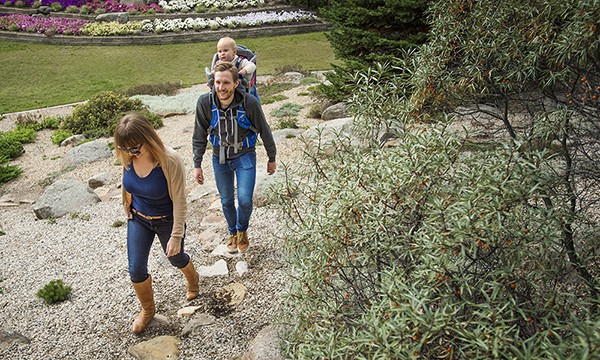
The walk to my university office is up a sandy path through a birch forest. Depending on the season, it is bathed in bottle green light, yellow birch leaves or snow-riven light shafts. The deer, grouse and moose tracks reminds me that the university garden I direct is a gem set in a forest.
From my office window I watch school busses disgorge excited students bent on learning how to grow seedlings, grandparents being dragged to the butterfly exhibit by anxious grandchildren and couples strolling idly past research plots. Groups of young moms sip coffee, enjoy each other’s company and trundle strollers through woodland glades. I smile at our horticultural staff pulling hoses and bringing joy.
Unfortunately, many visitors never realize that this is a University of Alberta facility, so on March 7 we officially change our name to the University of Alberta Botanic Garden (UABG), leaving our well-worn title of “Devonian Botanic Garden” after 43 years.
Our new name enlivens public expectations of our world-class academic institution, as a facility for the public good. This is our time to shine.
What does the garden actually do?

My professional horticulture staff loves, celebrates, elevates and showcases plants. How? They propagate, study, catalog, interpret, measure and display plants for visitors as they stroll the 240-acre outdoor museum of plants from around the globe.
Plant study has been the garden’s foundation since 1956 when J.A. Whyte, a University of Alberta botany professor, first suggested a botanic garden and Colonel Sandy Dyde donated the land. Our public good is through education, research projects, agricultural research and cultural interpretation.
My simple goal is that “no garden visitor depart unchanged”. The health benefits of being in nature are clear, thus, we welcome urban dwellers to safely and conveniently immerse themselves in a natural garden. I have watched garden annual visitation climb from 48,000 to over 75,000 in my six-year term and I have set the ambitious goal of exceeding 200,000 by 2020 with the help of some spectacular new features currently under construction.
As a professional educator, I am proud to see some of my former university students become expert naturalists and experiential education leaders, guiding more than 17,000 kindergarten to Grade 12 students in outdoor classes. I occasionally join them to co-teach as our students gambol in the woodlands, sweat over greenhouse studies, reflect in pond-side journaling and sometimes shriek at what they dredge up in pond studies. There is also time for the joyous unstructured play so critical to discovery experiences. Our Emerald Award-winning Kids in the Garden and Green School program graduates are urged to pursue additional U of A degrees later too.
Weekends at UABG have a different tone as events and programming staff produce a smorgasbord of events, courses and celebrations. For example, they offer more than 80 continuing education classes as varied as lily propagation, watercolor art, willow furniture and drumming. Our celebrations include Japanese culture, Canada Day, Date Nights, Pride Night, Opera in the Garden, Fruit Growers’ Festival and the ethereal winter candlelight of Luminaria.
I know in my bones why the world’s great universities such as Oxford, Harvard, Yale, Princeton, Cambridge, University of British Columbia and the University of Alberta all incorporate botanic gardens. University gardens expand experiential learning where nature and the human experience interact. Our garden research is active and university gardens allow an intuitively clear public view into systematic learning that is compelling as well as beckoning. The first steps to accepting, conserving and stewarding are familiarity and understanding. I want all Albertans to experience authentic engagement with plants and the cultures they support. That is the real garden path at the University of Alberta Botanic Garden. We hope you will walk it with us soon.

Dr. Lee Foote — Professor and Director, University of Alberta Botanic Garden, Faculty of Agricultural, Life and Environmental Sciences
Dr. Foote is a member of Botanic Gardens Conservation International, The University of Alberta Forestry School, and is a participant in the Land Reclamation International Graduate School sponsored by NSERC CREATE. Dr. Foote is currently co-PI on a SSHRC grant focused on digital interpretation of cultural and botanic gardens. He is an advisor on the Prairie Urban Farm initiative at South Campus as well as the ENCHANT model farm initiative through the Alberta Conservation Association.